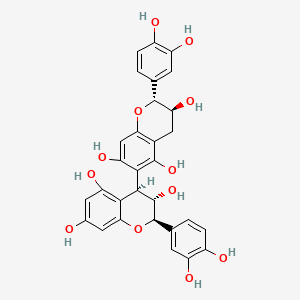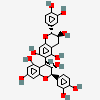Procyanidin B6
PubChem CID
474540
Molecular Formula
Synonyms
- Procyanidin B6
- 12798-58-2
- Procyanidol B6
- Procyanidin dimer B6
- catechin-(4alpha->6)-catechin
Molecular Weight
578.5 g/mol
Computed by PubChem 2.2 (PubChem release 2024.11.20)
Dates
- Create:2005-08-01
- Modify:2024-12-28
Description
Procyanidin B6 is a proanthocyanidin consisting of two molecules of (+)-catechin joined by a bond between positions 4 and 6' in alpha-configuration. Procyanidin B6 is isolated from leaves and fruit of cowberry Vaccinium vitis-idaea and other plants. It can also be found in grape seeds and in beer. It has a role as a metabolite. It is a hydroxyflavan, a proanthocyanidin and a biflavonoid. It is functionally related to a (+)-catechin.
Procyanidin B6 has been reported in Quercus miyagii, Nelumbo nucifera, and Salix sieboldiana with data available.
Chemical Structure Depiction

(2R,3S)-2-(3,4-dihydroxyphenyl)-6-[(2R,3S,4R)-2-(3,4-dihydroxyphenyl)-3,5,7-trihydroxy-3,4-dihydro-2H-chromen-4-yl]-3,4-dihydro-2H-chromene-3,5,7-triol
Computed by Lexichem TK 2.7.0 (PubChem release 2024.11.20)
InChI=1S/C30H26O12/c31-13-7-19(36)24-23(8-13)42-30(12-2-4-16(33)18(35)6-12)28(40)26(24)25-20(37)10-22-14(27(25)39)9-21(38)29(41-22)11-1-3-15(32)17(34)5-11/h1-8,10,21,26,28-40H,9H2/t21-,26-,28-,29+,30+/m0/s1
Computed by InChI 1.07.0 (PubChem release 2024.11.20)
GMISZFQPFDAPGI-ZBRHZRBFSA-N
Computed by InChI 1.07.0 (PubChem release 2024.11.20)
C1[C@@H]([C@H](OC2=C1C(=C(C(=C2)O)[C@H]3[C@@H]([C@H](OC4=CC(=CC(=C34)O)O)C5=CC(=C(C=C5)O)O)O)O)C6=CC(=C(C=C6)O)O)O
Computed by OEChem 2.3.0 (PubChem release 2024.11.20)
C30H26O12
Computed by PubChem 2.2 (PubChem release 2024.11.20)
- Procyanidin B6
- 12798-58-2
- Procyanidol B6
- Procyanidin dimer B6
- catechin-(4alpha->6)-catechin
- CHEBI:75619
- Catechin(4a->6)catechin
- SZ77QV8UB3
- (2R,3S)-2-(3,4-dihydroxyphenyl)-6-[(2R,3S,4R)-2-(3,4-dihydroxyphenyl)-3,5,7-trihydroxy-3,4-dihydro-2H-chromen-4-yl]-3,4-dihydro-2H-chromene-3,5,7-triol
- C-(4,6)-C
- (2r,2'r,3s,3's,4r)-2,2'-bis(3,4-dihydroxyphenyl)-3,3',4,4'-tetrahydro-2h,2'h-4,6'-bichromene-3,3',5,5',7,7'-hexol
- (2R,2R,3S,3S,4R)-2,2-Bis(3,4-dihydroxyphenyl)-3,3,4,4-tetrahydro(4,6-bi-2H-1-benzopyran)-3,3,5,5,7,7-hexol
- (4,6-Bi-2H-1-benzopyran)-3,3,5,5,7,7-hexol, 2,2-bis(3,4-dihydroxyphenyl)-3,3,4,4-tetrahydro-, (2R,2R,3S,3S,4R)-
- UNII-SZ77QV8UB3
- CHEMBL502984
- SCHEMBL13999378
- DTXSID001028815
- Catechin-(4.alpha.-->6)catechin
- HY-N12984
- (+)-Catechin-(4alpha-6)-(+)-catechin
- CS-1099836
- (+)-CATECHIN-(4.ALPHA.-6)-(+)-CATECHIN
- Q7247558
- (2R,3S,4R)-2-(3,4-dihydroxyphenyl)-4-[(2R,3S)-2-(3,4-dihydroxyphenyl)-3,5,7-trihydroxy-chroman-6-yl]chromane-3,5,7-triol
- (4,6-BI-2H-1-BENZOPYRAN)-3,3,5,5,7,7-HEXOL, 2,2-BIS(3,4-DIHYDROXYPHENYL)-3,3,4,4-TETRAHYDRO-, (2R-(2.ALPHA.,3.BETA.,4.ALPHA.(2R*,3S*)))-
- (4,6-Bi-2H-1-benzopyran)-3,3,5,5,7,7-hexol, 2,2-bis(3,4-dihydroxyphenyl)-3,3,4,4-tetrahydro-, (2R-(2alpha,3beta,4alpha(2R*,3S*)))-
Property Name
Property Value
Reference
Property Name
Molecular Weight
Property Value
578.5 g/mol
Reference
Computed by PubChem 2.2 (PubChem release 2024.11.20)
Property Name
XLogP3-AA
Property Value
2.4
Reference
Computed by XLogP3 3.0 (PubChem release 2024.11.20)
Property Name
Hydrogen Bond Donor Count
Property Value
10
Reference
Computed by Cactvs 3.4.8.18 (PubChem release 2024.11.20)
Property Name
Hydrogen Bond Acceptor Count
Property Value
12
Reference
Computed by Cactvs 3.4.8.18 (PubChem release 2024.11.20)
Property Name
Rotatable Bond Count
Property Value
3
Reference
Computed by Cactvs 3.4.8.18 (PubChem release 2024.11.20)
Property Name
Exact Mass
Property Value
578.14242626 Da
Reference
Computed by PubChem 2.2 (PubChem release 2024.11.20)
Property Name
Monoisotopic Mass
Property Value
578.14242626 Da
Reference
Computed by PubChem 2.2 (PubChem release 2024.11.20)
Property Name
Topological Polar Surface Area
Property Value
221Ų
Reference
Computed by Cactvs 3.4.8.18 (PubChem release 2024.11.20)
Property Name
Heavy Atom Count
Property Value
42
Reference
Computed by PubChem
Property Name
Formal Charge
Property Value
0
Reference
Computed by PubChem
Property Name
Complexity
Property Value
925
Reference
Computed by Cactvs 3.4.8.18 (PubChem release 2024.11.20)
Property Name
Isotope Atom Count
Property Value
0
Reference
Computed by PubChem
Property Name
Defined Atom Stereocenter Count
Property Value
5
Reference
Computed by PubChem
Property Name
Undefined Atom Stereocenter Count
Property Value
0
Reference
Computed by PubChem
Property Name
Defined Bond Stereocenter Count
Property Value
0
Reference
Computed by PubChem
Property Name
Undefined Bond Stereocenter Count
Property Value
0
Reference
Computed by PubChem
Property Name
Covalently-Bonded Unit Count
Property Value
1
Reference
Computed by PubChem
Property Name
Compound Is Canonicalized
Property Value
Yes
Reference
Computed by PubChem (release 2021.10.14)
Follow these links to do a live 2D search or do a live 3D search for this compound, sorted by annotation score. This section is deprecated (see here for details), but these live search links provide equivalent functionality to the table that was previously shown here.
Same Connectivity Count
Same Parent, Connectivity Count
Mixtures, Components, and Neutralized Forms Count
Similar Compounds (2D)
Similar Conformers (3D)
PubMed Count
Patents are available for this chemical structure:
https://patentscope.wipo.int/search/en/result.jsf?inchikey=GMISZFQPFDAPGI-ZBRHZRBFSA-N
The LOTUS Initiative for Open Natural Products Research: frozen dataset union wikidata (with metadata) | DOI:10.5281/zenodo.5794106
- CAS Common ChemistryLICENSEThe data from CAS Common Chemistry is provided under a CC-BY-NC 4.0 license, unless otherwise stated.https://creativecommons.org/licenses/by-nc/4.0/Procyanidin B6https://commonchemistry.cas.org/detail?cas_rn=12798-58-2
- ChemIDplusChemIDplus Chemical Information Classificationhttps://pubchem.ncbi.nlm.nih.gov/source/ChemIDplus
- EPA DSSToxProcyanidin B6https://comptox.epa.gov/dashboard/DTXSID001028815CompTox Chemicals Dashboard Chemical Listshttps://comptox.epa.gov/dashboard/chemical-lists/
- FDA Global Substance Registration System (GSRS)LICENSEUnless otherwise noted, the contents of the FDA website (www.fda.gov), both text and graphics, are not copyrighted. They are in the public domain and may be republished, reprinted and otherwise used freely by anyone without the need to obtain permission from FDA. Credit to the U.S. Food and Drug Administration as the source is appreciated but not required.https://www.fda.gov/about-fda/about-website/website-policies#linking
- ChEBI
- LOTUS - the natural products occurrence databaseLICENSEThe code for LOTUS is released under the GNU General Public License v3.0.https://lotus.nprod.net/Procyanidin B6https://www.wikidata.org/wiki/Q7247558LOTUS Treehttps://lotus.naturalproducts.net/
- ChEMBLLICENSEAccess to the web interface of ChEMBL is made under the EBI's Terms of Use (http://www.ebi.ac.uk/Information/termsofuse.html). The ChEMBL data is made available on a Creative Commons Attribution-Share Alike 3.0 Unported License (http://creativecommons.org/licenses/by-sa/3.0/).http://www.ebi.ac.uk/Information/termsofuse.html
- Japan Chemical Substance Dictionary (Nikkaji)
- Natural Product Activity and Species Source (NPASS)Catechin-(4Alpha->6)-Catechinhttps://bidd.group/NPASS/compound.php?compoundID=NPC263940
- Metabolomics WorkbenchCatechin-(4Alpha->6)-Catechinhttps://www.metabolomicsworkbench.org/data/StructureData.php?RegNo=139832
- Wikidataprocyanidin B6https://www.wikidata.org/wiki/Q7247558
- WikipediaThiopyryliumhttps://en.wikipedia.org/wiki/ThiopyryliumProcyanidin B6https://en.wikipedia.org/wiki/Procyanidin_B6
- PubChem
- MolGenieMolGenie Organic Chemistry Ontologyhttps://github.com/MolGenie/ontology/
- PATENTSCOPE (WIPO)SID 399245810https://pubchem.ncbi.nlm.nih.gov/substance/399245810
CONTENTS

